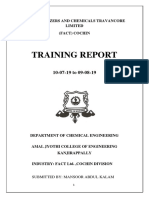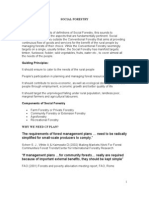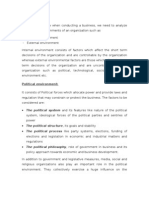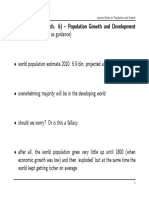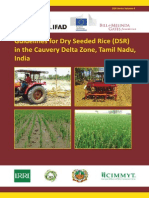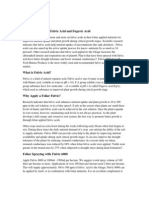CH 3 Agriculture & The Environment
CH 3 Agriculture & The Environment
Uploaded by
AyanCopyright:
Available Formats
CH 3 Agriculture & The Environment
CH 3 Agriculture & The Environment
Uploaded by
AyanOriginal Description:
Original Title
Copyright
Available Formats
Share this document
Did you find this document useful?
Is this content inappropriate?
Copyright:
Available Formats
CH 3 Agriculture & The Environment
CH 3 Agriculture & The Environment
Uploaded by
AyanCopyright:
Available Formats
1
CHAPTER 3: AGRICULTURE AND THE ENVIRONMENT
1. Soil: Formation, composition and uses
Soil is the loose material on the earth’s surface above the solid rock.
Soil is the topmost layer of the Earth’s crust.
Plants need soil for growth.
Plants in turn are the basis of the chain which supports humans and all the
land animals upon which humans feed.
The thickness of the soil layer varies greatly from place to place.
Most soils have three layers called horizons.
Soil consists of organic matter (dead remains and wastes of plants and
animals), mineral matter (sand, silt and clay), water and air
Half of the soil by volume is not solid (made up of air and water) varies because
of Weather
Texture is the balance of mineral particles in a soil. Soil texture is important as
it affects many of factors which influence plant growth and farming like Pore
space, aeration drainage nutrients and ease of use
Plants need minerals like nitrogen, phosphorous and potassium for healthy
growth.
Mineral particles are formed by weathering of the rock that lies below the soil.
In areas of natural vegetation, dead leaves and other waste matter in the soil.
This is the nutrient cycle.
Soil acidity is measured by the pH Scale. (5.5 to 8 ideal for farming) Above 8
saline soil, below 5.5 acid soil (restrict root access to water and nutrients)
Sandy soils are describe as hungry soils
Best soil for farming is loamy soil.
Types of Farming
Arable farming is growing crops only
pastoral farming is keeping and grazing animals
Mixed farming when farmers grow crops and keep livestock as well.
Commercial farming is growing crops and keeping animals for sale
Hamza Mir 03429450059 Agriculture & Environment
2
i) Commercial Arable Farming (either one crop or limited, ex: Banana plantation in Central
America, operated by big companies)
ii) Commercial Pastoral Farming (one type of animal is kept for sale)
Subsistence farming is growing crops and keeping animals mainly to feed the family. One
of the most traditional forms of Subsistence farming is shifting cultivation, widely practiced
in the tropical forests of South America and South East Asia.
Advantage: no population pressure & no serious forest destruction
Disadvantage: output is very low per hectare and less population is supported
Extensive farming is producing a low output per hectare from large areas of land
Intensive farming is producing high output per hectare
Commercial arable farmers often concentrate on growing just one crop, or at best a limited
number of crops. Tropical plantation agriculture is a good example.
In Tropical plantation agriculture one crop is widely grown on plantation in central and
South America for export worldwide.
These plantations are owned by and operated by big companies.
Shifting cultivation in tropical rainforest
A small plot of forest is cleared by slash and then burn
Crops such as maize, rice and bananas are planted
Nothing special for their growth is added to the soil. They are just harvested when ready.
After 2/3 years, soil loses its fertility and the plot is abandoned.
So another plot needs to be cleared to carry out to this produce again.
Plants and small trees grow rapidly and takes over the abandoned plot
Wet rice (padi) cultivation in Asia
Monsoon brigs heavy rains between June and September.
Flat flood plains and deltas make flooding the fields easier
Silt soils are fertile ,deep and easy to work
Hamza Mir 03429450059 Agriculture & Environment
3
Large number of people living in rural areas work in the fields
Hand labour is needed for planting seeds in nurseries, transplanting rice into the fields
harvesting and threshing rice cultivation also requires a lot of labor
Agricultural techniques to increase to yields
1. Irrigation
Supply of water from lakes, rivers, reservoirs etc.
Water transferred from areas of storage used by canals
Water sprayed by sprinklers to provide equal amount over wide area
Ex: Hot Deserts (Egypt, Middle East etc.), Savanna and Monsoon (a dry season during
which temp is high)
2. Chemicals (fertilizers and pesticides)
Natural shortage of mineral nutrients in a soil
Nitrogen fertilizers, Ammonium nitrate and ammonium sulphate provide soluble
nitrogen to plants
Insecticides to destroy crop eating insects
Herbicide sprays can kill weeds (compete with crop for light and nutrients)
Fungicides
Possible to grow the same crop on the same piece of land year after year.
3. Mechanization
4. Selective breeding of plants
5. Genetically modified organisms
6. controlled environments
Genetically modified organisms
Hamza Mir 03429450059 Agriculture & Environment
4
i. Genetic engineering: It is the process of altering the genetic composition of an organism by
modifying its own genes or introducing genes from a different species. It involves the
transfer of genes from one organism to an unrelated species.
ii. Biotechnology: It is the use of living organisms or biological process for industrial,
agricultural, or medical purposes.
The different types of GM crops
i. Pest resistant Bt crops :Plants are protecting against insect damage by producing a toxin,
found in the common soil, bacterium
ii. Herbicide tolerant: that are not affected by the adverse effects of HERBICIDES.
iii. Disease resistant: that are not effected by viral plan diseases
iv. Modifying plant products: food could be produced that offered higher level of nutrients
and vitamins
Controlled environments
Controlled environments such as greenhouses are used mainly in countries with cool
climates as in Northern America
Hydroponics is an extreme form of glasshouse production.
Soil is replaced by mineral solution pumped around the plant root.
In Crop rotation, with rotation crops grown on any plot of land change from one growing
season to the next.
When one crop is replaced by another minerals taken out by one crop can be replaced by
another. Therefore a good rotation system maintains soil fertility and structure, increases
crop yield and reduces the risk of soil erosion
The adverse effects of modern agricultural practices
Hamza Mir 03429450059 Agriculture & Environment
5
(a)Overuse of chemical pesticides and inorganic fertilizers
The water is starved of oxygen by decomposing of dead algae that process is known as
eutrophication.
Eutrophication is due to surplus use of fertilizers, drain into water ,water plants such as
algae grow ,blocks sunlight, decomposition of dead algae, less oxygen for marine
organisms.
Pesticides kill other organisms in the soil too, such as bacteria.
Salinization due to the input of large quantity of water on soil surface.
(b) Overuse and mismanagement of irrigation water
Concentration areas of irrigation water on the surface
Salts are drawn up to the top of the soil as moisture is evaporated
Further evaporation leaves the salts behind in the topsoil
A hard crust salt is deposited on the surface
Salt concentration around plant roots
As most plants and crops cannot tolerate high salt levels, they wither and die.
(c) Over cultivation and overgrazing of farm land
Exhaustion of mineral ion content
Soil erosion
desertification
Human impacts
The worst human impact of modern agricultural practices is that the rich get richer, the poor get
poorer.
In developing countries, modern agricultural practices favour large scale operators over small scale
farmers.
Big farmers benefit from “Economics of scale”, this means the larger the farm, the less it costs to
cultivate on hectare of land.
Big landowners can often make more money by specializing in growing one crop (monoculture)
instead of many crops (polyculture).
Monoculture is less good for the soil than polyculture.
Hamza Mir 03429450059 Agriculture & Environment
6
Soil erosion: causes and impacts
(a)Causes of soil erosion
Soil erosion is the loss of top soil by wind and water.
Deforestation
Overgrazing
Overcultivation
wrongs farming practices
Clearance of natural vegetation.
(b) Impacts of soil erosion
Reduction of crop yields
Land become less productive
Farmers spend more on fertilizers to improve yields, so their income goes
down and expenditure rises.
Sediments of soil after being washed away settle on seabed.
Siltation will occur with accumulation of the soil in Dams.
They are costly to remove and increased amount of sediments in dams can
cause flooding.
Famine
Desertification
Causes and consequences of desertification
It is the process whereby land is turned into a desert.
(a) Causes
Decline in rainfall
Hamza Mir 03429450059 Agriculture & Environment
7
Overgrazing
Over cultivation
Irrigation and salinization
Increased demand for food and fuel
All these factors lead to decline in vegetation cover and so increase soil
erosion by wind and water which leads to desertification.
(b) Consequences
Reduction in crops so as a result less food.
Reduced total biomass, so less food for livestock.
Reduced wood biomass, hence less wood for fuel.
Reduced water availability, underground supplies increases
Increase disruption to life, people need for relief aid increases leading
migration
(c)Conservation of soil
Increase in terraced farming
Increased contour ploughing
Plant trees in line to check wind aped and to protect soil from wind
erosion.
Use the system of mixed /inter cropping (plants between trees) to protect
them from being eroded by winds.
Grow more grass around the crops to maintain surface cover and humus
of the soil.
Soil erosion: management strategies
The aim of soil conservation is the prevention of soil erosion so that the fertile topsoil retained.
(a)Mechanical method
Hamza Mir 03429450059 Agriculture & Environment
8
The main strategy used for conservation in mountainous areas is terracing.
Terracing built across slops hold the soil on flatter land. These are needed most in tropical
lands where most rain fall heavy storms. On a small scale there are bunds, for which stones
are placed across the lower ends of steep slopes to hold back soil and water.
Contour ploughing (ploughing around or across the slope instead of up and down).
Ridges formed by ploughing block the downward movement of water on slopes
(b) Changes in farming practices
Rates of erosion are low when the soil is covered, so following strategies are used
Mixed cropping
Crop rotation add organic matter
Tree planting
Strategies for sustainable agriculture
Behind the concept of sustainable agriculture is the idea that we should not be putting
at risk tomorrow’s food supplies from the land because of today’s short term economic
greed. There are following six strategies helpful to sustainable agriculture.
Use organic fertilizer
Crop rotation
Pest and drought resistant crop varieties
Managing livestock grazing
Trickle drip irrigation
Rainwater harvesting
Past Papers Questions
Hamza Mir 03429450059 Agriculture & Environment
9
Q. What are the advantages of using legumes instead of fertilizer for the farmer
and for the ecosystem?
Ans. legumes can be ploughed in after the crop to increase nutrients in the soil,
legumes are a useful supply of beans/peas/animal fodder,
legumes are less expensive/fertilizers are more expensive,
danger to the environment of over-fertilization/legumes are more environmentally
friendly, eutrophication, leads to death of plants/fish,
Q. Describe the methods farmers could use to grow crops in dry climate.
Ans. method of storage of water described
channels / pipes bring water from storage
sprinkler / other suitable method on terrace
care needed not to over water / not to induce run off
wells dug to tap into underground water supplies
(ii) dry land farming
widely spaced plants, no competition for small amount of water available
mulch / straw etc. on surface, protects from evaporation
protects from wind erosion
grass strips between crops, reduce soil erosion explained
GM drought resistant crops
Plant seeds / crops after the rain
Q .Describe what has been done to allow farming to take place in hilly areas?
Ans. terracing / land cut into steps
flat areas
across slope / parallel to contours
narrow(er) on steep(er) slopes / wide(r) on gentle(r) slopes
bunds / low walls at the edges
(ii) steep slope
(terrace) encourages / increases infiltration
decreases run-off
conserves soil / soil not washed down the slope (terrace or bund)
contour ploughing so water sinks into furrows
plough ridges prevent water from flowing downhill
easier farming practices
Q. Describe the role of soil organisms in maintaining soils.
Ans.
Hamza Mir 03429450059 Agriculture & Environment
10
decomposition; of (dead) plant material; of (dead) fauna);and turn them into
nutrients / humus /minerals; worms aerate the soil; move down / mix organic
material through the soil; role of organisms in: carbon cycle, nitrogen cycle, sulfur
cycle;
Q. Explain how fertilisers may damage the environment and suggest how their
environmental impacts can be reduced.
Ans.
excess fertilisers washed into water courses leading to algal blooms and
eutrophication, with effects of plant and animal life in the water; controlled
application to limit excess fertilisers and possibly use of organic
fertilisers;clearance of algal blooms, oxygenation of water courses affected.
OR
provides detailed explanation of how fertilisers can damage the environment, but
nothing worthy of credit on reduction or vice versa
Q. Explain how the overuse and misuse of chemical fertilizers is harmful to
the environment.
Ans. Pollution of rivers / groundwater
With excess nitrates / phosphates
Algae multiply rapidly
On decomposition they reduce the oxygen in the water
Eutrophication
Plant / animal life in the water dies
Q. How could a farmer increase crop yields using alternatives to chemical
fertilisers?
Ans . use organic fertilizer / manure
Use compost
Mix farming
Crop rotation
Using nitrogen fixing plants eg using leguminous crops / peas / beans etc after
cereals
Q. What is meant by dry land farming?
Hamza Mir 03429450059 Agriculture & Environment
11
Ans. Farming in dry areas without irrigation
Q. Suggest reasons why farmers may prefer to use inorganic fertilisers rather
than organic ones.
Ans. Cheaper, easier to obtain, easier to apply lower mass, more pleasant / less smell
from them / quicker release, does not keep animals, does not wish to rotate / grow few
crops types, can target nutrients needed.
Q. State advantages of GM.
Ans.no competition with weeds, so better yields, only need to use one type of weed
killer
Q. Describe possible problems of having large areas of monoculture.
Ans. Loss of biodiversity, loss of insect pollinations, damage to soil, reduce fertility, soil
capping, soil pan formed
Q. Why do some people think that growing GM is a risk to environment?
Ans. Genes for resistance to roundup passed on to other species, by cross pollination,
loss of crop varieties
Q. Why does a scientist ask more than one person for collecting his data?
Ans. reliability, to calculate average / mean, for comparison, to give a more complete
picture.
Q. How the scientist would have made sure that the sample from all the site were
Comparable?
Ans. repeat the sampling, more time / stated time, repeat around another site.
Q. What is meant by rainwater harvesting?
Ans. This is trapping, collecting and storing rainwater which otherwise have been lost
as runoff down the drains or into streams.
.Q. State three environmental benefits of rainwater harvesting?
Ans .
Reducing runoff
Decreasing the risk of floods and soil erosion
Save the amount of water
Hamza Mir 03429450059 Agriculture & Environment
12
Q. Why can rainwater harvesting be described as an example of appropriate
technology?
ans. rainwater harvesting can be done by individuals or community groups
Q. Give a brief definition for each of the following:
(a) Organic fertilizer
Organic manure is known as Organic fertilizer
(b) Crop rotation
The main advantage of crop rotation is maintenance of soil fertility. If crops of different
sizes and periods of growth are planted in neighbouring fields.
(c) Managing grazing
Do not have too many animals for the amount of vegetation available
(d) Resistant crop varieties
Development of crop varieties that showed resistant from pests, herbicides and
diseases etc.
Hamza Mir 03429450059 Agriculture & Environment
You might also like
- The Rise of Modern International Order: George LawsonDocument15 pagesThe Rise of Modern International Order: George LawsonTatiana Peña ReyNo ratings yet
- Fact Report CDDocument30 pagesFact Report CDmansoorkalamNo ratings yet
- Agriculture in A NutshellDocument6 pagesAgriculture in A NutshellTravis Yee ShuiNo ratings yet
- Problems of The Philippine Agricultural SectorDocument4 pagesProblems of The Philippine Agricultural SectorStephanny S. CellacayNo ratings yet
- Dragonlance - Ergoth 1 - A Warroir's Jorney PDFDocument217 pagesDragonlance - Ergoth 1 - A Warroir's Jorney PDFmartin_corkerNo ratings yet
- A Critical Discussion On The Methods Currently Recommended To Support Organic Crop Farming in IndiaDocument19 pagesA Critical Discussion On The Methods Currently Recommended To Support Organic Crop Farming in IndiaGangaNo ratings yet
- Form 03B Tangible Movable - Ethnographic Object 2017Document3 pagesForm 03B Tangible Movable - Ethnographic Object 2017ValNo ratings yet
- What Are The Main Problems of Agriculture SectorDocument4 pagesWhat Are The Main Problems of Agriculture SectorKhalid AzizNo ratings yet
- Reaction Paper (Envi Chem)Document3 pagesReaction Paper (Envi Chem)Chelzi DizonNo ratings yet
- 19 Promoting Sustainable Forest Management Through Community Forestry in The PhilippinesDocument14 pages19 Promoting Sustainable Forest Management Through Community Forestry in The PhilippinesJanine PalizaNo ratings yet
- Introduction To Public SectorDocument12 pagesIntroduction To Public SectorIshika AroraNo ratings yet
- 2 Terminology To Philosophy of ExtensionDocument72 pages2 Terminology To Philosophy of ExtensionChristian Delas HerrasNo ratings yet
- Presentation1ss ReforestationDocument12 pagesPresentation1ss ReforestationYasotha VijayabalanNo ratings yet
- Life On LandDocument8 pagesLife On LandHatoon MalikNo ratings yet
- Synthesis Sample EssayDocument5 pagesSynthesis Sample EssayAlexandru DuicuNo ratings yet
- Social ForestryDocument6 pagesSocial ForestryUgyen LhendupNo ratings yet
- Land ReformDocument6 pagesLand ReformMd Shahedul IslamNo ratings yet
- Sources of Timber Products in Caraga RegionDocument41 pagesSources of Timber Products in Caraga Regionrank_gunNo ratings yet
- Agrarian Reform and The Difficult Road To Peace in The Philippine CountrysideDocument12 pagesAgrarian Reform and The Difficult Road To Peace in The Philippine CountrysideKeneith Gaspar100% (1)
- The Socio-Economic Impact of Establishments of Electricity and NetworkDocument46 pagesThe Socio-Economic Impact of Establishments of Electricity and NetworkmelchieNo ratings yet
- EUP Steps With FPADocument15 pagesEUP Steps With FPAJudd AdaNo ratings yet
- Ecotourism Completion ReportDocument8 pagesEcotourism Completion ReportMILLER J. VILLAS50% (2)
- Weeds & Its ManagementDocument50 pagesWeeds & Its ManagementQuinnee VallejosNo ratings yet
- Answers To Module 2 of Urban Geography 3Document26 pagesAnswers To Module 2 of Urban Geography 3Johanisa DeriNo ratings yet
- Political EnvironmentDocument2 pagesPolitical EnvironmentdhanubalakrishnanNo ratings yet
- Todaro Migration ModelDocument3 pagesTodaro Migration ModelHamad RazaNo ratings yet
- Supplemental Material - Rice Tariffication LawDocument23 pagesSupplemental Material - Rice Tariffication LawAlma Mae CortezNo ratings yet
- Lesson 4: Food, Green Revolution and BiotechnologyDocument15 pagesLesson 4: Food, Green Revolution and BiotechnologyJeson GaiteraNo ratings yet
- Concepts of Land ReformDocument66 pagesConcepts of Land ReformAlisha Palala100% (1)
- Planning A Plan Is A Course ofDocument14 pagesPlanning A Plan Is A Course ofHuryatNo ratings yet
- Budget Reform BillDocument3 pagesBudget Reform BillMark Joseph BajaNo ratings yet
- Effects of El Nino On The Agua Operations in Toril, Davao CityDocument7 pagesEffects of El Nino On The Agua Operations in Toril, Davao CityJong AbearNo ratings yet
- Topic 8: Regional Economic IntegrationDocument37 pagesTopic 8: Regional Economic IntegrationSozia Tan100% (1)
- Gmo EssayDocument2 pagesGmo EssayGelene MartinNo ratings yet
- Oposa v. FactoranDocument1 pageOposa v. FactoranJamiah Obillo HulipasNo ratings yet
- 7 Environmental Principles of NatureDocument3 pages7 Environmental Principles of NaturePrin Cez0% (1)
- Essay On Global WarmingDocument2 pagesEssay On Global WarmingUzzaam Haider100% (1)
- 16.role of Agriculture in Economic Rural DevelopmentDocument14 pages16.role of Agriculture in Economic Rural DevelopmentramkumarNo ratings yet
- Nation Climate Change Action Plan 2011-2028Document128 pagesNation Climate Change Action Plan 2011-2028Arangkada PhilippinesNo ratings yet
- CHN Life On LandDocument2 pagesCHN Life On LandClarissa Marie LimmangNo ratings yet
- Local Government Code Section 17 of RA 7160 (For Provinces)Document3 pagesLocal Government Code Section 17 of RA 7160 (For Provinces)Nykolsha Mae Closas RayosNo ratings yet
- Population CompositionDocument20 pagesPopulation CompositionAlga BijuNo ratings yet
- Water in The PhilippinesDocument5 pagesWater in The PhilippinesHannah MorataNo ratings yet
- Policy ImplementationDocument10 pagesPolicy ImplementationwubeNo ratings yet
- Urban and Regional Planning Report (Local Government Code)Document19 pagesUrban and Regional Planning Report (Local Government Code)Sherlock HoImes100% (1)
- Components of Environment and Natural Resources MGMTDocument4 pagesComponents of Environment and Natural Resources MGMTAditi Agrawal100% (1)
- President Ferdinand E. Marcos (1965-1986)Document5 pagesPresident Ferdinand E. Marcos (1965-1986)SVTKhsiaNo ratings yet
- 28516-3R - City-Report - Zamboanga City, Region IX, The Philippines PDFDocument10 pages28516-3R - City-Report - Zamboanga City, Region IX, The Philippines PDFOmar Perez Dela MercedNo ratings yet
- Population GrowthDocument39 pagesPopulation Growthmr j100% (1)
- Transparency of Transactions and Access To Information: Republic Act No. 6713Document16 pagesTransparency of Transactions and Access To Information: Republic Act No. 6713Erickah PerladoNo ratings yet
- Presentation On GlobalizationDocument28 pagesPresentation On Globalizationasron00786% (14)
- Calabanga ProjectDocument45 pagesCalabanga ProjectEdgar SalomonNo ratings yet
- Implementing Rules and Regulations EO No. 138Document32 pagesImplementing Rules and Regulations EO No. 138Majin BukayNo ratings yet
- Reaction Paper PhilippinesDocument4 pagesReaction Paper PhilippinesAbam AbamNo ratings yet
- Agriculture and EnvironmentDocument6 pagesAgriculture and EnvironmentAshutosh ChatterjeeNo ratings yet
- Critical Analysis of Agrarian ReformDocument20 pagesCritical Analysis of Agrarian ReformJerome Nuguid40% (5)
- Linear Stage of Growth ModelDocument34 pagesLinear Stage of Growth ModelMia Bumagat100% (1)
- Climate Change Adaptation Strategies of The Department of Agriculture in Davao Region, PhilippinesDocument4 pagesClimate Change Adaptation Strategies of The Department of Agriculture in Davao Region, PhilippinesIJSREDNo ratings yet
- Reengineering ReinventingDocument4 pagesReengineering ReinventingTaz Tanggol Tabao-SumpinganNo ratings yet
- Lyceum of The Philippines University CaviteDocument37 pagesLyceum of The Philippines University CaviteJamila Irish Masinas0% (1)
- Food ResourcesDocument20 pagesFood ResourceshiranNo ratings yet
- Decentralization and BureacratizationDocument23 pagesDecentralization and BureacratizationClare JavierNo ratings yet
- CH 3 AGRICULTURE & THE ENVIRONMENTDocument12 pagesCH 3 AGRICULTURE & THE ENVIRONMENTwajidsipra4906No ratings yet
- 1assignment SMOH5103Document32 pages1assignment SMOH5103Harithas Bujanapprasath0% (1)
- Identify Farm Tools ExamDocument23 pagesIdentify Farm Tools ExamSisley CanilloNo ratings yet
- Text StructureDocument19 pagesText Structureapi-291467690No ratings yet
- DUS Test of Melon in JapanDocument20 pagesDUS Test of Melon in Japandina isnainiNo ratings yet
- Fert SojaDocument115 pagesFert SojaArroz Agua TambeñoNo ratings yet
- Setting Up of Proper Waste Management in Ihm GwaliorDocument69 pagesSetting Up of Proper Waste Management in Ihm GwaliorAmitKumarYadav100% (1)
- Ele HortDocument69 pagesEle HortNiraj GurjarNo ratings yet
- CHAMBERS 7 and 8 Cultivating Female and Male Sexual EnergyDocument13 pagesCHAMBERS 7 and 8 Cultivating Female and Male Sexual Energyhostcares9100% (4)
- Total Diet Study Analytical MethodsDocument32 pagesTotal Diet Study Analytical MethodsSanti santikNo ratings yet
- CharcoalVinegar With PicturesDocument37 pagesCharcoalVinegar With PicturesWil AlgonesNo ratings yet
- Stress Corrosion Cracking - A Caustic ExperienceDocument3 pagesStress Corrosion Cracking - A Caustic Experienceramadoss_alwar7307No ratings yet
- Alternative Approach For Granular Fertilizers - CompactionDocument26 pagesAlternative Approach For Granular Fertilizers - CompactionAurelio PortoNo ratings yet
- Vijay Antony Organic Private Limited: Production of Organic Horticulture Vegetables and Fruits in Large ScaleDocument23 pagesVijay Antony Organic Private Limited: Production of Organic Horticulture Vegetables and Fruits in Large ScaleDapinder Pal SinghNo ratings yet
- Mohit Cluster BeanDocument21 pagesMohit Cluster BeanMOHIT SomaniNo ratings yet
- How To Make Gunpowder in The WildDocument19 pagesHow To Make Gunpowder in The WildIqroAlam100% (1)
- Vermicomposting Classroom ActivitiesDocument34 pagesVermicomposting Classroom ActivitiesPennsylvania Association for Sustainable AgricultureNo ratings yet
- How To Grow BananasDocument4 pagesHow To Grow BananassupermaneditNo ratings yet
- Integrated Farming ClusterDocument6 pagesIntegrated Farming Clusterthokerarif302No ratings yet
- Garden SenseDocument132 pagesGarden SenseRose WhiteNo ratings yet
- DSR Tamilnadu EnglishDocument46 pagesDSR Tamilnadu Englishapi-279376651No ratings yet
- Organic Fertilizer Project ProposalDocument13 pagesOrganic Fertilizer Project Proposalsewmelkam1985100% (2)
- Hi Tech HumaxDocument2 pagesHi Tech Humaxzf00770No ratings yet
- Divya Pruthvi Agronomics PVTDocument33 pagesDivya Pruthvi Agronomics PVTPiyush ChaturvediNo ratings yet
- CamelliaDocument2 pagesCamelliaVictor Hugo SantosNo ratings yet
- Hydroponics With AquacultureDocument28 pagesHydroponics With AquacultureDimas Urip SNo ratings yet
- Modern Agriculture PracticeDocument81 pagesModern Agriculture PracticeH Janardan PrabhuNo ratings yet
- Drought Tolerant Planting KENT WILDLIFE TRUSTDocument2 pagesDrought Tolerant Planting KENT WILDLIFE TRUSTglynisNo ratings yet

